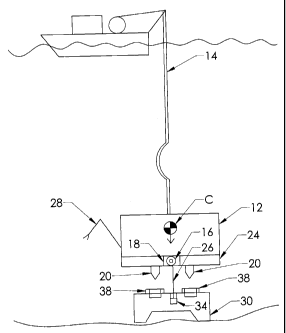Some of the information on this Web page has been provided by external sources. The Government of Canada is not responsible for the accuracy, reliability or currency of the information supplied by external sources. Users wishing to rely upon this information should consult directly with the source of the information. Content provided by external sources is not subject to official languages, privacy and accessibility requirements.
Any discrepancies in the text and image of the Claims and Abstract are due to differing posting times. Text of the Claims and Abstract are posted:
| (12) Patent: | (11) CA 2802875 |
|---|---|
| (54) English Title: | METHOD AND APPARATUS FOR UNDERWATER COUPLING |
| (54) French Title: | PROCEDE ET APPAREIL DE COUPLAGE SOUS-MARIN |
| Status: | Granted |
| (51) International Patent Classification (IPC): |
|
|---|---|
| (72) Inventors : |
|
| (73) Owners : |
|
| (71) Applicants : |
|
| (74) Agent: | NEXUS LAW GROUP LLP |
| (74) Associate agent: | |
| (45) Issued: | 2016-11-29 |
| (22) Filed Date: | 2013-01-18 |
| (41) Open to Public Inspection: | 2014-07-18 |
| Examination requested: | 2015-01-29 |
| Availability of licence: | N/A |
| (25) Language of filing: | English |
| Patent Cooperation Treaty (PCT): | No |
|---|
| (30) Application Priority Data: | None |
|---|
A method and apparatus for underwater coupling of an underwater craft and an underwater package. The underwater craft has a centre of mass with a winch positioned in a winch pocket directly below the centre of mass. A first underwater coupling assembly is provided having two or more first coupling components positioned symmetrically around the winch pocket. The underwater package has a centre of mass with a lift line receiver positioned in a receiver pocket directly above the centre of mass. A second underwater coupling assembly is provided having two or more second coupling components positioned symmetrically around the receiver pocket. A lift line is lowered and engages the lift line receiver. The winch is activated to draw the underwater craft down onto the underwater package and bring the coupling components into coupling engagement.
Procédé et appareil de couplage sous-marin dune embarcation sous-marine et dun paquet sous-marin. Lembarcation sous-marine comporte un centre de masse doté dun treuil positionné dans une pochette de treuil, directement sous le centre de masse. Un premier ensemble de couplage sous-marin est prévu et doté dun ou de plusieurs premiers composants de couplage positionnés de façon symétrique autour de la pochette de treuil. Le paquet sous-marin comporte un centre de masse doté dun élément daccueil de câble de levage positionné dans une pochette daccueil directement au-dessus du centre de masse. Un deuxième ensemble de couplage sous-marin est prévu et doté de deux ou de plusieurs deuxièmes éléments de couplage positionnés de façon symétrique autour du paquet daccueil. Un câble de levage est abaissé et entraîne lélément daccueil du câble de levage. Le treuil est activé pour attirer lembarcation sous-marine vers le bas, sur le paquet sous-marin, et réunir les éléments de couplage de façon à ce quils soient engagés.
Note: Claims are shown in the official language in which they were submitted.
Note: Descriptions are shown in the official language in which they were submitted.

For a clearer understanding of the status of the application/patent presented on this page, the site Disclaimer , as well as the definitions for Patent , Administrative Status , Maintenance Fee and Payment History should be consulted.
| Title | Date |
|---|---|
| Forecasted Issue Date | 2016-11-29 |
| (22) Filed | 2013-01-18 |
| (41) Open to Public Inspection | 2014-07-18 |
| Examination Requested | 2015-01-29 |
| (45) Issued | 2016-11-29 |
There is no abandonment history.
Last Payment of $125.00 was received on 2023-11-28
Upcoming maintenance fee amounts
| Description | Date | Amount |
|---|---|---|
| Next Payment if small entity fee | 2025-01-20 | $125.00 |
| Next Payment if standard fee | 2025-01-20 | $347.00 |
Note : If the full payment has not been received on or before the date indicated, a further fee may be required which may be one of the following
Patent fees are adjusted on the 1st of January every year. The amounts above are the current amounts if received by December 31 of the current year.
Please refer to the CIPO
Patent Fees
web page to see all current fee amounts.
| Fee Type | Anniversary Year | Due Date | Amount Paid | Paid Date |
|---|---|---|---|---|
| Application Fee | $200.00 | 2013-01-18 | ||
| Maintenance Fee - Application - New Act | 2 | 2015-01-19 | $50.00 | 2014-11-20 |
| Request for Examination | $400.00 | 2015-01-29 | ||
| Maintenance Fee - Application - New Act | 3 | 2016-01-18 | $50.00 | 2016-01-15 |
| Final Fee | $150.00 | 2016-10-18 | ||
| Maintenance Fee - Patent - New Act | 4 | 2017-01-18 | $50.00 | 2017-01-18 |
| Maintenance Fee - Patent - New Act | 5 | 2018-01-18 | $100.00 | 2018-01-18 |
| Maintenance Fee - Patent - New Act | 6 | 2019-01-18 | $100.00 | 2019-01-04 |
| Maintenance Fee - Patent - New Act | 7 | 2020-01-20 | $100.00 | 2020-01-02 |
| Maintenance Fee - Patent - New Act | 8 | 2021-01-18 | $100.00 | 2020-12-17 |
| Maintenance Fee - Patent - New Act | 9 | 2022-01-18 | $100.00 | 2021-12-22 |
| Maintenance Fee - Patent - New Act | 10 | 2023-01-18 | $125.00 | 2022-11-16 |
| Maintenance Fee - Patent - New Act | 11 | 2024-01-18 | $125.00 | 2023-11-28 |
Note: Records showing the ownership history in alphabetical order.
| Current Owners on Record |
|---|
| CANADIAN SCIENTIFIC SUBMERSIBLE FACILITY |
| Past Owners on Record |
|---|
| None |